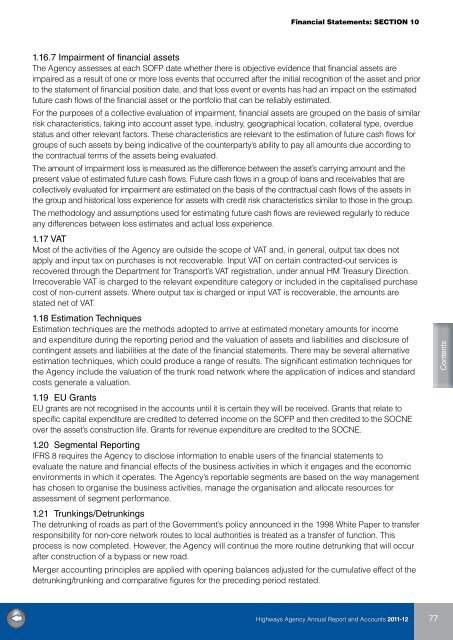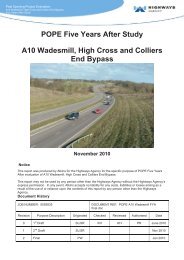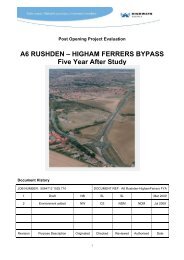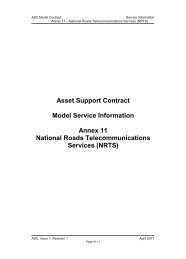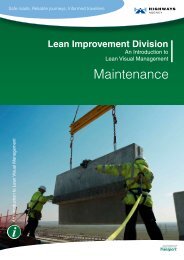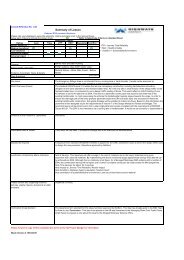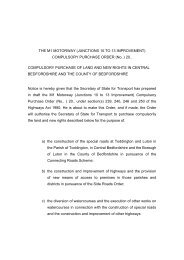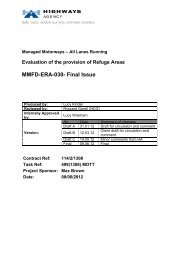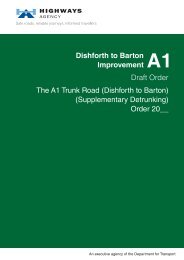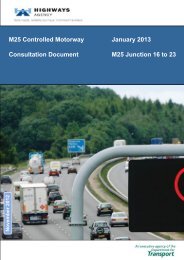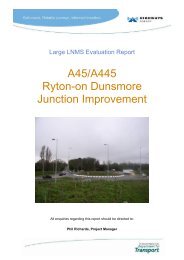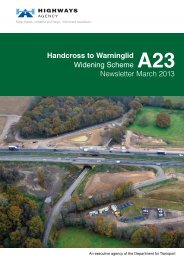Highways Agency Annual Report and Accounts 2011-2012
Highways Agency Annual Report and Accounts 2011-2012
Highways Agency Annual Report and Accounts 2011-2012
Create successful ePaper yourself
Turn your PDF publications into a flip-book with our unique Google optimized e-Paper software.
Financial Statements: SECTION 10<br />
1.16.7 Impairment of financial assets<br />
The <strong>Agency</strong> assesses at each SOFP date whether there is objective evidence that financial assets are<br />
impaired as a result of one or more loss events that occurred after the initial recognition of the asset <strong>and</strong> prior<br />
to the statement of financial position date, <strong>and</strong> that loss event or events has had an impact on the estimated<br />
future cash flows of the financial asset or the portfolio that can be reliably estimated.<br />
For the purposes of a collective evaluation of impairment, financial assets are grouped on the basis of similar<br />
risk characteristics, taking into account asset type, industry, geographical location, collateral type, overdue<br />
status <strong>and</strong> other relevant factors. These characteristics are relevant to the estimation of future cash flows for<br />
groups of such assets by being indicative of the counterparty’s ability to pay all amounts due according to<br />
the contractual terms of the assets being evaluated.<br />
The amount of impairment loss is measured as the difference between the asset’s carrying amount <strong>and</strong> the<br />
present value of estimated future cash flows. Future cash flows in a group of loans <strong>and</strong> receivables that are<br />
collectively evaluated for impairment are estimated on the basis of the contractual cash flows of the assets in<br />
the group <strong>and</strong> historical loss experience for assets with credit risk characteristics similar to those in the group.<br />
The methodology <strong>and</strong> assumptions used for estimating future cash flows are reviewed regularly to reduce<br />
any differences between loss estimates <strong>and</strong> actual loss experience.<br />
1.17 VAT<br />
Most of the activities of the <strong>Agency</strong> are outside the scope of VAT <strong>and</strong>, in general, output tax does not<br />
apply <strong>and</strong> input tax on purchases is not recoverable. Input VAT on certain contracted-out services is<br />
recovered through the Department for Transport’s VAT registration, under annual HM Treasury Direction.<br />
Irrecoverable VAT is charged to the relevant expenditure category or included in the capitalised purchase<br />
cost of non-current assets. Where output tax is charged or input VAT is recoverable, the amounts are<br />
stated net of VAT.<br />
1.18 Estimation Techniques<br />
Estimation techniques are the methods adopted to arrive at estimated monetary amounts for income<br />
<strong>and</strong> expenditure during the reporting period <strong>and</strong> the valuation of assets <strong>and</strong> liabilities <strong>and</strong> disclosure of<br />
contingent assets <strong>and</strong> liabilities at the date of the financial statements. There may be several alternative<br />
estimation techniques, which could produce a range of results. The significant estimation techniques for<br />
the <strong>Agency</strong> include the valuation of the trunk road network where the application of indices <strong>and</strong> st<strong>and</strong>ard<br />
costs generate a valuation.<br />
1.19 EU Grants<br />
EU grants are not recognised in the accounts until it is certain they will be received. Grants that relate to<br />
specific capital expenditure are credited to deferred income on the SOFP <strong>and</strong> then credited to the SOCNE<br />
over the asset’s construction life. Grants for revenue expenditure are credited to the SOCNE.<br />
1.20 Segmental <strong>Report</strong>ing<br />
IFRS 8 requires the <strong>Agency</strong> to disclose information to enable users of the financial statements to<br />
evaluate the nature <strong>and</strong> financial effects of the business activities in which it engages <strong>and</strong> the economic<br />
environments in which it operates. The <strong>Agency</strong>’s reportable segments are based on the way management<br />
has chosen to organise the business activities, manage the organisation <strong>and</strong> allocate resources for<br />
assessment of segment performance.<br />
1.21 Trunkings/Detrunkings<br />
The detrunking of roads as part of the Government’s policy announced in the 1998 White Paper to transfer<br />
responsibility for non-core network routes to local authorities is treated as a transfer of function. This<br />
process is now completed. However, the <strong>Agency</strong> will continue the more routine detrunking that will occur<br />
after construction of a bypass or new road.<br />
Merger accounting principles are applied with opening balances adjusted for the cumulative effect of the<br />
detrunking/trunking <strong>and</strong> comparative figures for the preceding period restated.<br />
<strong>Highways</strong> <strong>Agency</strong> <strong>Annual</strong> <strong>Report</strong> <strong>and</strong> <strong>Accounts</strong> <strong>2011</strong>-12


